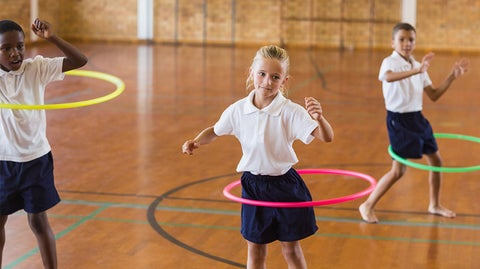Providing Additional Sensory Motor Opportunities By Enhancing Sensory Pathways
Like any skill, practicing the movement and repeating the motor pattern enhances performance. Our sensory system needs to be stimulated on a regular basis throughout the day if we are to learn to self-regulate our bodies within an environment.

Recall a time when you took a toddler or preschooler on an escalator for the first time. Do you remember how fearful they were? Or the first time on a roller coaster or even a swing? Children may be fearful at first, but once the sensory system is “primed” and stimulated, the willingness of the child to do more often improves. In fact, they may find that they love the swing and want to do it all day!
Activities that stimulate the senses – specifically the vestibular, proprioceptive and tactile sense – are essential for teaching self-regulation.
Fun and easy ways to promote sensory motor opportunity include the creation of sensory pathways. Sensory pathways, when created with the understanding of the essential sensory components that promote midline crossing and motor planning opportunities (vestibular, tactile, and proprioception), are easy to make and are essential for every child. Sensory pathways are a great way to utilize under-utilized spaces, such as hallways and sidewalks, while giving children more opportunities to practice some of the motor planning and sensory motor skills they desperately need for development.
When planning a sensory pathway, make sure to link activities that provide opportunity for midline crossing (e.g. stepping across midline or reaching across midline), weight-bearing activities (e.g. wall push, leg push, yoga poise), and locomotor skills (jumping, hopping, leaping) that enhance and promote motor planning.
When planning a sensory pathway, consider ways to provide continuity across environments. Moving from the classroom to the hallway and out onto the playground are all areas where a child can practice sensory motor activities.
For example, when creating sensory pathways in schools, embed movement pathways for the classroom such as walking to the front of the room in a zig zag or cross stepping. Placing yoga poses in each corner is another great way to provide the sensory seeker in your class a chance to self-regulate.
In the hallway, utilize stickers to create a pathway that provides lots of choices to move to include wall spots for pushing and midline crossing. Use Reusable Stencils to create visual paths to and from the playground using animal tracks, dinosaur prints, or even hopscotch with numbers. Instant games and activities can easily be painted onto the playground surface. For situations that are not as permanent, consider the vinyl rollouts that have movement pathways designed to engage creative movements.
These activities and more can be great for children with sensory processing issues, Developmental Coordination Disorder (DCD), ADHD and Autism.
At the end of the day, ALL children can benefit because we are ALL sensory beings!
ABOUT THE AUTHOR

Timothy D. Davis, Ph.D. CAPE teaches undergraduate and graduate courses at the State University of New York (SUNY) Cortland. Some of his courses include Adapted Physical Activity and Sport, Motor Development, Instructional Strategies in APE, Inclusive Outdoor Education and Positive Behavior Management and Discipline. He has been teaching for over 20 years and holds bachelor's and master's degrees in Physical Education and Adapted Physical Education from California State University at Chico. He holds a Ph.D. in Adapted Physical Education from the University of Virginia.
At SUNY Cortland, Dr. Davis serves as director of the SUNY Cortland CHAMP/I Can Do It Afterschool Peer Mentorship Program and the Sensory Integration/Motor Integration (SIMS) program. He is the creator of Project DREAM, a learning program that helps kids and students with disabilities, and Project LEAPE, a leadership course dedicated to helping kids and adults with disabilities.
Have further questions? Dr. Tim can be reached by visiting this page.
Updated 3/11/2022



Leave a comment